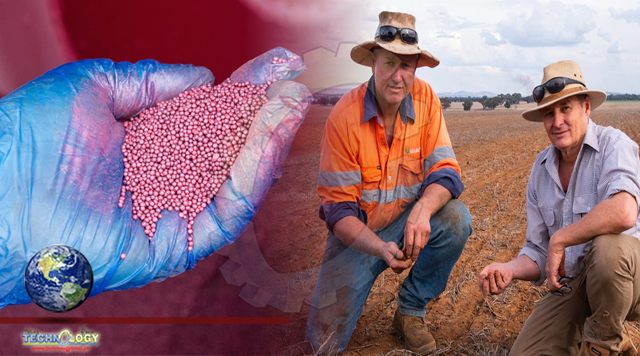“It’s always a battle for farmers to maintain soil carbon and over the whole cropping belt worldwide we’ve lost about 60 per cent of our soil organic carbon out of our cropping soils,” Mr Webb said.

By Luke Wong
Agriculture usually involves taking something off or out of the land and selling it, but agronomist Guy Webb wants to put a commodity into the soil and leave it there.
Key points:
- Soil Carbon Co is exploring the potential of microbes to sequester carbon in agricultural soils
- The company has developed a crop seed inoculum that it says can increase soil carbon
- The federal government has committed funding to increase the viability of carbon farming
“It’s always a battle for farmers to maintain soil carbon and over the whole cropping belt worldwide we’ve lost about 60 per cent of our soil organic carbon out of our cropping soils,” Mr Webb said.
That problem inspired him on a decade-long mission to find a solution that will tackle two problems at once.
“If we can draw carbon out of the atmosphere, and trap it in the soil, which increases soil health, we’re doing something about climate change mitigation at the same time,” he said.
Developing a solution
In 2019, Mr Webb co-founded Soil Carbon Co, a start-up that has attracted more than $10 million in private and government funding.
The company is exploring if microbes can store stable carbon in soil to enhance the world’s agricultural paddocks as giant carbon dioxide sinks.
At Soil Carbon Co’s research centre in Orange, central-western NSW, chief product officer and co-founder Tegan Nock leads a group of scientists researching a group of fungi called dark septate endophytes.
They have sifted through a library of 1,500 microbes to find the ones best suited for carbon sequestration.
The company has developed a fungal treatment, or inoculum, that when applied to crop seeds, builds carbon as stable sugars around the roots of plants, Ms Nock said.
She said the product was a tool that would help the agricultural industry to meet future carbon targets.
“We have to be able to make some real inroads to be able to give farmers some practical tools … to be able to shift the dial on carbon,” she said.
Ms Nock said field trials on crops had returned positive results, recording an average 7 per cent yield increase and a 2.6-tonne increase in tradable carbon per hectare.
She said the fungal inoculum was able to build the types of stable soil carbon that could stay in the ground for hundreds or even thousands of years.
“It’s something that’s really heartening to see in terms of that effect to be able to not just increase carbon that’s tradable, but really stable carbon to give that certainty on that trade,” she said.
Maturing carbon market
Farm manager Rob Atkinson is trialling the inoculum on a canola crop at nearby Canowindra.
He is enthusiastic about its potential dual benefits for landholders.
“I think this is a great opportunity to try and use farmers … to put carbon in the soil that is going to be there forever in a day, and help the environment along the way and get paid for it,” Mr Atkinson said.
Soil carbon researcher Susan Orgill of the NSW Department of Primary Industries said there was growing interest in carbon sequestering biotechnologies.
“It’s a really exciting and promising part of our soil carbon science,” Dr Orgill said.
“We know that in low disturbance agriculture, while fungi might only be say 10 per cent of the total microbial biomass, they’re responsible for between 35 and 75 per cent of all carbon that’s sequestered.”
While soil carbon projects make up 14 per cent of projects registered under the Emissions Reduction Fund, she said momentum was building.
“I think the carbon market may have been slow but I think now it’s really maturing.”
Increasing carbon farming viability
The carbon market is estimated to be worth $40 billion to the land sector by 2050.
In the this year’s budget, the federal government committed almost $200 million to a National Soil Strategy.
This funding includes a scheme to pay rebates to farmers who share their soil data, and investment in innovations to reduce the cost of soil carbon measuring by 90 per cent.
Mr Webb said increasing the financial viability of carbon farming would help more producers enter the trading market.
“As soon as there’s money in the game, I think farmers will adopt it a lot,” Mr Webb said.
Ultimately, he said widespread adoption of carbon farming would benefit everyone, not just those working on the land.
“What has excited me about this project that even if you don’t believe in climate change, you can still participate in solving climate change by drawing carbon in the soil,” he said.
“You might be just in it to get a better crop and better soils, but it’s for all and everybody.”
Originally published at Abc news